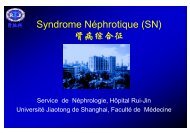The impact of rehabilitation on chronic whiplash
The impact of rehabilitation on chronic whiplash
The impact of rehabilitation on chronic whiplash
Create successful ePaper yourself
Turn your PDF publications into a flip-book with our unique Google optimized e-Paper software.
130 J.-M. Gosnold<br />
Table 1 Risk and prognostic factors for <strong>whiplash</strong> injury. 9<br />
Risk/prognostic Type <str<strong>on</strong>g>of</str<strong>on</strong>g> factor Factor<br />
Risk factor Demographic Female<br />
Age<br />
Physical History <str<strong>on</strong>g>of</str<strong>on</strong>g> neck pain<br />
Collisi<strong>on</strong> with heavier vehicle<br />
Rear-end <str<strong>on</strong>g>impact</str<strong>on</strong>g><br />
Seatbelt use<br />
Prognostic factor Demographic Female<br />
Increasing age<br />
Married/cohabiting<br />
Greater number <str<strong>on</strong>g>of</str<strong>on</strong>g> dependents<br />
Family history <str<strong>on</strong>g>of</str<strong>on</strong>g> neck pain<br />
Physical Fatality/severe injury involved<br />
Stati<strong>on</strong>ary vehicle<br />
Lack <str<strong>on</strong>g>of</str<strong>on</strong>g> seatbelt use<br />
Unpreparedness at <str<strong>on</strong>g>impact</str<strong>on</strong>g><br />
Rotated or inclined head positi<strong>on</strong><br />
Multiple injuries involved<br />
Initial head/neck pain intensity<br />
Cervical spine degenerati<strong>on</strong><br />
Psychosocial Expectati<strong>on</strong> <str<strong>on</strong>g>of</str<strong>on</strong>g> disability<br />
Table 1 shows those factors known to influence risk<br />
and prognosis according to Hurwitz. 9<br />
To fully understand the mechanism <str<strong>on</strong>g>of</str<strong>on</strong>g> injury,<br />
knowledge <str<strong>on</strong>g>of</str<strong>on</strong>g> how both vehicles and occupants<br />
behave in a crash is necessary, 10 the main determining<br />
factor being related to the type <str<strong>on</strong>g>of</str<strong>on</strong>g> <str<strong>on</strong>g>impact</str<strong>on</strong>g><br />
involved (i.e. fr<strong>on</strong>tal, side, or rear-end collisi<strong>on</strong>s).<br />
Numerous research studies in recent years have<br />
provided valuable informati<strong>on</strong> <strong>on</strong> both the mechanism<br />
<str<strong>on</strong>g>of</str<strong>on</strong>g> injury and the factors leading to the likelihood<br />
<str<strong>on</strong>g>of</str<strong>on</strong>g> chr<strong>on</strong>ic symptoms and risk <str<strong>on</strong>g>of</str<strong>on</strong>g> l<strong>on</strong>g-term<br />
disability.<br />
<str<strong>on</strong>g>The</str<strong>on</strong>g> following case dem<strong>on</strong>strates how SMT al<strong>on</strong>e<br />
may not provide the full functi<strong>on</strong>al and symptomatic<br />
recovery achievable by an individual with a<br />
chr<strong>on</strong>ic neck problem, especially when post-traumatic<br />
in nature.<br />
Case presentati<strong>on</strong><br />
Mrs. G, a slim, fit, 31-year-old part-time music<br />
teacher and mother <str<strong>on</strong>g>of</str<strong>on</strong>g> two young children, presented<br />
with pain between the shoulder blades<br />
and lower neck <str<strong>on</strong>g>of</str<strong>on</strong>g> 6 m<strong>on</strong>ths durati<strong>on</strong>, following a<br />
road traffic accident. She explained that she had<br />
been driving a Ford M<strong>on</strong>deo at approximately<br />
50 mph when a vehicle <str<strong>on</strong>g>of</str<strong>on</strong>g> similar size pulled out<br />
in fr<strong>on</strong>t <str<strong>on</strong>g>of</str<strong>on</strong>g> her at a crossroads. Despite braking, she<br />
hit the side <str<strong>on</strong>g>of</str<strong>on</strong>g> this car, resulting in her vehicle being<br />
written <str<strong>on</strong>g>of</str<strong>on</strong>g>f. At <str<strong>on</strong>g>impact</str<strong>on</strong>g>, she felt a severe jarring<br />
sensati<strong>on</strong> to her upper back and neck as she was<br />
restrained by her seatbelt. <str<strong>on</strong>g>The</str<strong>on</strong>g>re was no loss <str<strong>on</strong>g>of</str<strong>on</strong>g><br />
c<strong>on</strong>sciousness. Although a headrest was present,<br />
Mrs. G was unable to recall if her head made c<strong>on</strong>tact<br />
with it and explained that, as she and her husband<br />
shared the car, she had never bothered to positi<strong>on</strong><br />
the headrest to provide specific support. Initial<br />
<strong>on</strong>set <str<strong>on</strong>g>of</str<strong>on</strong>g> pain was felt in the anterior chest and right<br />
shoulder, with an increasing awareness <str<strong>on</strong>g>of</str<strong>on</strong>g> upper<br />
back and posterior neck pain developing within half<br />
an hour. Hospital examinati<strong>on</strong>, including X-ray<br />
examinati<strong>on</strong> <str<strong>on</strong>g>of</str<strong>on</strong>g> her cervical spine, was unremarkable<br />
and she was discharged without treatment.<br />
<str<strong>on</strong>g>The</str<strong>on</strong>g> pain was described as a ‘‘c<strong>on</strong>stant deep<br />
ache’’, coupled with some ‘‘burning’’ pain felt<br />
between the shoulder blades towards the end <str<strong>on</strong>g>of</str<strong>on</strong>g><br />
the day. On a visual analogue pain scale, the intensity<br />
ranged from 3/10 (tending to be in the mornings),<br />
to 8/10 at worst (tending to be in the late<br />
afterno<strong>on</strong>/evenings). Further questi<strong>on</strong>ing revealed<br />
that her symptoms were exacerbated by most<br />
housework and when performing her duties as a<br />
music teacher, especially when seated at a desk.<br />
Temporary relief had been provided by sleep,<br />
Transcutaneous Electric Nerve Stimulati<strong>on</strong> (TENS)<br />
and by osteopathic manipulati<strong>on</strong> and s<str<strong>on</strong>g>of</str<strong>on</strong>g>t tissue<br />
work. <str<strong>on</strong>g>The</str<strong>on</strong>g>re was no prior history <str<strong>on</strong>g>of</str<strong>on</strong>g> previous neck<br />
or upper back problems.<br />
On examinati<strong>on</strong>, postural evaluati<strong>on</strong> revealed<br />
marked anterior head carriage and a prominent<br />
kyphotic curve at the cervico-thoracic juncti<strong>on</strong>.<br />
<str<strong>on</strong>g>The</str<strong>on</strong>g> regi<strong>on</strong>al examinati<strong>on</strong> revealed marked restricti<strong>on</strong>s<br />
in cervical rotati<strong>on</strong> to the left, coupled with





